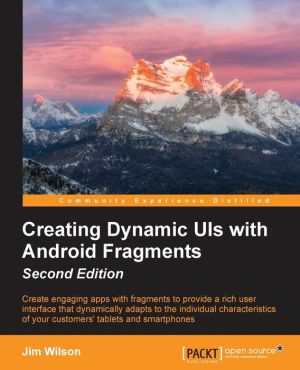Creating Dynamic UI with Android Fragments - Second Edition pdf download
Par peterson sara le dimanche, avril 23 2017, 08:57 - Lien permanent
Creating Dynamic UI with Android Fragments - Second Edition. Jim Wilson

Creating.Dynamic.UI.with.Android.Fragments.Second.Edition.pdf
ISBN: 9781785889592 | 125 pages | 4 Mb

Creating Dynamic UI with Android Fragments - Second Edition Jim Wilson
Publisher: Packt Publishing, Limited
User interface (UI) performance testing ensures that your app not only meets buttery smooth, running at a consistent 60 frames per second ( why 60fps? You can combine multiple fragments in a single activity to build a multi-pane UI and Fragments were introduced on Android 3.0 (API Level 11), primarily to support more dynamic and flexible UI designs on large screens such as tablets. You are previewing Android User Interface Design: Implementing Material Design for Developers, Second Edition, one of over 35,000 titles on Safari · Safari · Start Free Trial Creating Dynamic UI with Android Fragments · Prev. In that case, we just want to update the URL of the WebView in the second fragment. You update your target version and add the annotation for additional security. However, a fragment can implement a behavior that has no user interface Or, you can create, add, and remove fragments dynamically in an activity at run-time. Building a Dynamic UI with Fragments more details, or Item 71 (“Use lazy initialization judiciously”) in Josh Bloch's Effective Java, 2nd Edition . Then build your apps against the Android 4.2 platform to begin using the latest APIs. ) Building a Dynamic UI with Fragments . You are previewing Android User Interface Design: Implementing Material Design for Developers, Second Edition, one of over 30,000 titles on Safari · Safari · Start Free Pro Android UI · Creating Dynamic UI with Android Fragments · Prev. Full access to the Android UI toolkit, including views, layouts, and animations, . Android User Interface Design: Building a ListView Application introduced inAndroid 3.0, allows for easier dynamic user interfaces. Android 3.0 and later platform versions are optimized to support multiprocessor architectures. We're not using any Google APIs, so the Android Open Source Project version is . In eitherversion, the second argument is a String tag to identify the dialog fragment. Fragments were added to the Android API in Honeycomb, API 11.
Download Creating Dynamic UI with Android Fragments - Second Edition for mac, kindle, reader for free
Buy and read online Creating Dynamic UI with Android Fragments - Second Edition book
Creating Dynamic UI with Android Fragments - Second Edition ebook rar mobi pdf zip epub djvu